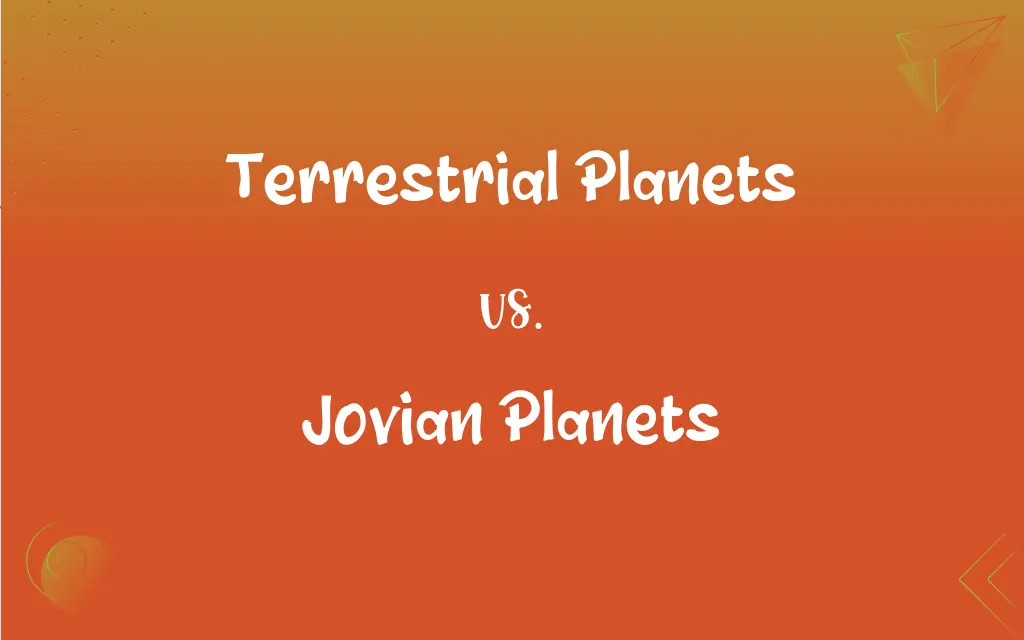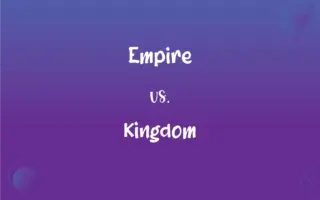Terrestrial Planets vs. Jovian Planets: What's the Difference?
Edited by Janet White || By Harlon Moss || Updated on October 23, 2023
Terrestrial planets are rocky and close to the Sun (e.g., Earth); jovian planets are gas giants farther out (e.g., Jupiter).

Key Differences
Terrestrial planets are the inner planets closest to the Sun, characterized by their solid, rocky surfaces. Jovian planets, also known as gas giants, are the outer planets with thick gaseous atmospheres and lack a solid surface.
Terrestrial planets generally have thinner atmospheres, and their compositions are dominantly silicate rocks and metals. Jovian planets possess deep atmospheres comprised primarily of hydrogen and helium, hiding any potential core deep within.
In terms of size and mass, terrestrial planets are considerably smaller and less massive than the jovian counterparts. Jovian planets boast significant size and mass, often with diameters and masses many times that of Earth.
Gravitational forces around terrestrial planets are weaker due to their smaller masses. In contrast, the massive jovian planets have strong gravitational pulls, which is why they've amassed large, thick atmospheres over time.
The climates and weather patterns of terrestrial planets are influenced by their proximity to the Sun, leading to warmer temperatures and more varied conditions. Meanwhile, jovian planets experience colder temperatures and possess strong, turbulent storms given their greater distances from the Sun and thick atmospheres.
ADVERTISEMENT
Comparison Chart
Composition
Rocky surfaces.
Gas giants with thick atmospheres.
Location in Solar System
Close to the Sun.
Farther from the Sun.
Size & Mass
Smaller and less massive.
Larger and more massive.
Atmosphere
Thinner, mostly non-hydrogen based.
Thick, dominantly hydrogen and helium.
Temperature & Weather
Warmer and varied.
Colder with strong, turbulent storms.
ADVERTISEMENT
Terrestrial Planets and Jovian Planets Definitions
Terrestrial Planets
Planets that are smaller and denser than gas giants.
Compared to Jupiter, Earth is much smaller, marking it as a terrestrial planet.
Jovian Planets
Planets with turbulent weather and immense storms.
The Great Red Spot on Jupiter, a massive storm, signifies its status as a jovian planet.
Terrestrial Planets
Inner planets with solid surfaces.
Mars, with its vast plains and canyons, is a terrestrial planet.
Jovian Planets
Gas giants located farther from the Sun.
Saturn, with its stunning rings, is a jovian planet.
Terrestrial Planets
Rocky planets closest to the Sun.
Mercury, being close to the Sun, is one of the terrestrial planets.
Jovian Planets
Celestial bodies with strong gravitational forces.
Uranus, being a gas giant, has a strong gravitational pull, making it a jovian planet.
Terrestrial Planets
Planets with thinner atmospheres.
Venus, despite its thick clouds, is categorized among terrestrial planets due to its solid surface.
Jovian Planets
Large planets with thick, hydrogen-rich atmospheres.
Neptune's blue hue stems from its thick atmosphere, classifying it as a jovian planet.
Terrestrial Planets
Celestial bodies primarily composed of silicate rocks.
Earth's crust is primarily silicate, making it a terrestrial planet.
Jovian Planets
Planets that lack a definite solid surface.
Dive into Jupiter, and you'd encounter layers of gases and possibly a core, but no solid surface.
FAQs
What defines jovian planets?
Jovian planets are gas giants farther from the Sun, such as Jupiter.
Which planets are considered jovian?
Jupiter, Saturn, Uranus, and Neptune are jovian planets.
How many terrestrial planets are in our solar system?
There are four terrestrial planets: Mercury, Venus, Earth, and Mars.
Why are terrestrial planets rocky?
Terrestrial planets formed close to the Sun where lighter gases were blown away, leaving heavy materials to solidify.
Is there a possibility of life on jovian planets?
While jovian planets' atmospheres are harsh, their moons might have conditions conducive to life.
What causes the greenish-blue color of Uranus and Neptune?
The presence of methane in the atmospheres of Uranus and Neptune gives them a greenish-blue tint.
What are terrestrial planets?
Terrestrial planets are rocky planets closest to the Sun, like Earth.
Which terrestrial planet is closest to the Sun?
Mercury is the closest terrestrial planet to the Sun.
How many moons do jovian planets have?
Jovian planets have multiple moons; Jupiter and Saturn have over 50 known moons each.
Which terrestrial planet is known for its red appearance?
Mars is often called the "Red Planet" due to its reddish appearance.
Do jovian planets have solid surfaces?
Jovian planets lack definitive solid surfaces; they have thick atmospheres covering any potential core.
Can life exist on terrestrial planets?
Earth supports life, but conditions on other terrestrial planets currently seem inhospitable.
Which jovian planet is known for its ring system?
Saturn is famously known for its expansive ring system.
Why are jovian planets called gas giants?
Jovian planets are termed gas giants because of their massive, gaseous atmospheres.
Which jovian planet has a prominent storm called the "Great Red Spot"?
Jupiter is home to the Great Red Spot, a massive storm.
Do all terrestrial planets have an atmosphere?
While all terrestrial planets have some form of atmosphere, they vary in thickness and composition.
Do terrestrial planets have moons?
Yes, for instance, Earth has one moon, while Mars has two small moons.
Are terrestrial planets denser than jovian planets?
Yes, terrestrial planets are denser due to their rocky compositions.
Are terrestrial planets larger than jovian planets?
No, terrestrial planets are generally smaller than jovian planets.
Why are jovian planets colder than terrestrial ones?
Jovian planets are farther from the Sun, resulting in colder temperatures.
About Author
Written by
Harlon MossHarlon is a seasoned quality moderator and accomplished content writer for Difference Wiki. An alumnus of the prestigious University of California, he earned his degree in Computer Science. Leveraging his academic background, Harlon brings a meticulous and informed perspective to his work, ensuring content accuracy and excellence.
Edited by
Janet WhiteJanet White has been an esteemed writer and blogger for Difference Wiki. Holding a Master's degree in Science and Medical Journalism from the prestigious Boston University, she has consistently demonstrated her expertise and passion for her field. When she's not immersed in her work, Janet relishes her time exercising, delving into a good book, and cherishing moments with friends and family.






































































